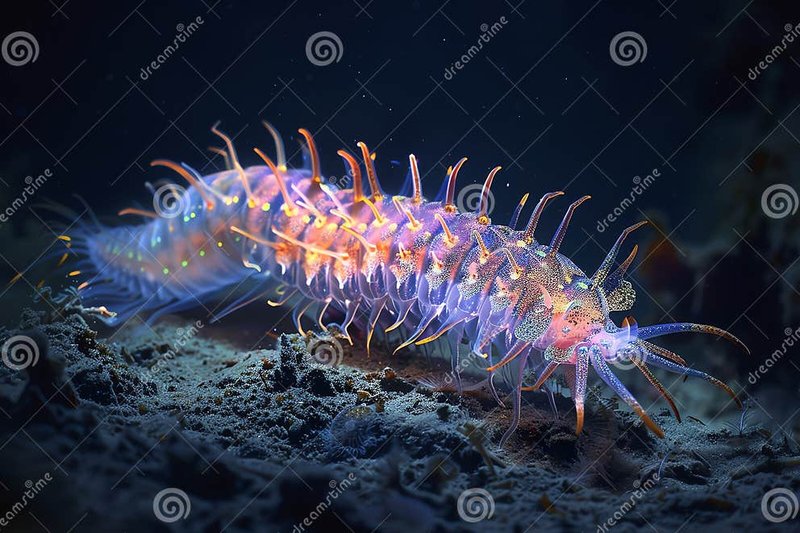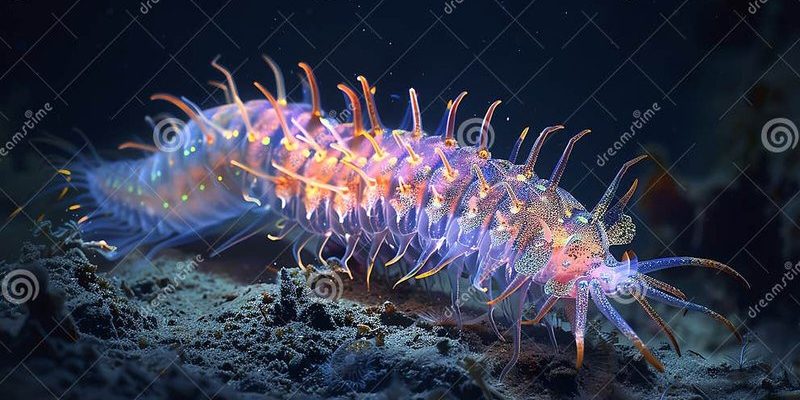
Bristle worms come in various shapes and colors, but those species that possess bioluminescent abilities truly stand out. They use this trait for several reasons, like attracting mates, deterring predators, or luring in prey. Watching them glow is like witnessing a secret celebration of life that not many get to see. So, if you’re curious about these shining wonders of the ocean, let’s dive deeper.
What Are Bioluminescent Bristle Worms?
Bioluminescent bristle worms are marine creatures belonging to the class Polychaeta. They make their homes in a variety of environments, from sandy seafloors to coral reefs. The **bioluminescence** in these worms comes from a chemical reaction involving a substance called luciferin. When luciferin interacts with oxygen, it produces light, similar to how fireflies light up summer nights.
You might be wondering why bioluminescence matters for these worms. For starters, it plays a critical role in their survival. The glow can help them evade predators by confusing them or scaring them off. It can also attract mates during the breeding season. In the dark depths of the ocean, finding a partner can be quite the challenge, so this glow becomes an essential tool in their nightly dance of romance.
Meet Some Notable Species
There are several species of bioluminescent bristle worms, each with its own unique glow and behaviors. Let’s take a closer look at a few of them:
- Odontosyllis enopla: This species is known for its dazzling blue light, which it emits when disturbed. Found in various oceanic regions, its light can be a stunning sight against the dark waters.
- Hyalinoecia tubicola: With a softer, bluish-green glow, this bristle worm uses its light not only for protection but also to attract prey. The glow serves as a lure, pulling in smaller fish that get a bit too curious.
- Palola viridis: Known as the “green bristle worm,” it exhibits a bright, almost fluorescent green hue. This species often comes out in swarms during the full moon, creating a breathtaking display that can light up the surroundings.
Each of these species showcases the diversity and adaptability of bristle worms in their bioluminescent abilities, making them a fascinating subject of study for marine biologists and enthusiasts alike.
How Do They Produce Light?
The science behind how these worms emit light is fascinating. The process is known as *bioluminescence*, and it primarily involves two components: **luciferin** and **luciferase**. When luciferin is oxidized, it produces light in a reaction catalyzed by the enzyme luciferase. This reaction requires oxygen, which is why these glowing displays often occur in well-oxygenated waters.
Imagine this process like a tiny fireworks show deep beneath the waves. Just as a firework needs air to ignite, the bioluminescent properties of bristle worms rely on the right conditions to spark their glow. Most of the time, this light is seen during the night, making it a special phenomenon for those lucky enough to observe it.
You might be surprised to learn that bioluminescence isn’t just for show. The light can change in intensity or color, allowing the worms to communicate or respond to various stimuli. The next time you’re at the beach and see glimmers in the surf, think about all the tiny creatures beneath the surface, using their light to navigate their world.
The Role in the Ecosystem
Bioluminescent bristle worms play a critical role in their ecosystems. They are not just beautiful; they act as both predators and prey in the vast oceanic food web. By emitting light, these worms can attract smaller fish and plankton, making it easier for them to find a meal. At the same time, they themselves are a food source for larger marine animals, including fish and crabs.
In addition, by breaking down organic materials, they contribute to nutrient cycling in marine environments. This process helps maintain healthy ecosystems, ensuring that energy flows smoothly from one organism to another. Without these remarkable worms, the delicate balance of ocean life could be disrupted.
Let’s not forget the human impact on these creatures. The health of marine ecosystems is critical. Overfishing, pollution, and climate change are all threats to their habitats. Understanding the role of bioluminescent bristle worms can enhance our appreciation for them and motivate us to protect the oceans they call home.
How to Observe Bioluminescent Bristle Worms
If you’re eager to witness the magic of bioluminescent bristle worms, there are a few ideal locations and conditions to keep in mind. First, these worms thrive in **tropical and subtropical waters**, so areas like the Caribbean or coral reefs are promising. Many coastal regions also experience stunning occurrences of bioluminescence—think about a night stroll along the beach after heavy rains.
The best time to observe these glowing wonders is during the night, especially on moonless nights when the stars are shining. Dark conditions will make the bioluminescence pop even more. As you explore marine environments, keep an eye out for disturbances in the water, which may indicate the presence of these glowing worms.
One way to enhance your experience is by snorkeling or diving. The underwater world can be mesmerizing, and seeing bioluminescent species up close is unforgettable. Just make sure to take care not to disturb their habitats, as many marine life forms are vulnerable to changes in their environment. Respect the oceans, and they’ll continue to amaze you with their secrets.
Conservation and Protection Efforts
As we marvel at the beauty of bioluminescent bristle worms, it’s essential to acknowledge the importance of protecting their habitats. Unfortunately, many coastal ecosystems face threats from climate change, pollution, and overfishing. These factors can impact not only the worms but also the entire marine ecosystem.
Organizations and scientists worldwide are working towards conserving these habitats through various initiatives. Restoration projects aim to rehabilitate coral reefs and reduce pollutants entering the oceans. Sustainable fishing practices also play a vital role in ensuring that marine life, including bioluminescent bristle worms, remain secure in their environments.
As individuals, we can contribute to these efforts, too. Simple actions like reducing plastic use, supporting local conservation groups, and being mindful of our footprint can go a long way in helping preserve these vibrant ecosystems. After all, every little bit helps, and it’s our responsibility to protect the beauty of the oceans.
Bristle worms, particularly those that exhibit bioluminescence, offer a glimpse into the wonders of the ocean. Their ability to produce vibrant light not only captures our attention but also serves important ecological functions. As we continue to explore the depths of the ocean, let’s remember these glowing creatures and the roles they play in maintaining a balance in marine ecosystems.
If you find yourself lucky enough to witness their glow, take a moment to appreciate the beauty and mystery of bioluminescent bristle worms. The world beneath the waves is full of surprises and is worth protecting for future generations to enjoy. So, next time you’re by the water, look closely—you just might see a little magic shining beneath the surface.

